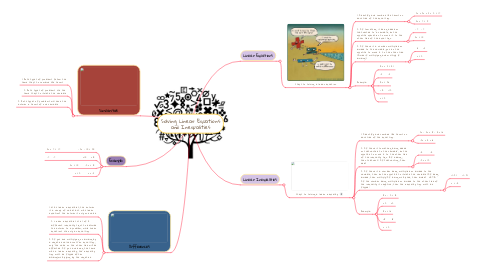
1. Example:
1.1. 5x + 7 = 17 -2x - 10 > 20
1.2. -7 -7 +10 +10
1.3. 5x = 10 -2x > 10
1.4. x = 2 x < -5
2. Similarities
2.1. 1. Both types of problems follow the same steps to combine like terms
2.2. 2. Both types of problems use the same steps to isolate the variable
2.3. 3. Both types of problems will have the answer in terms of one variable
3. Linear Equations
3.1. Steps to solving a linear equation
3.1.1. 1. Identify and combine like terms on each side of the equal sign.
3.1.1.1. 2x + 3x + 5 + 2 = 17
3.1.1.2. 5x + 7 = 17
3.1.2. 2. If something is being added or subtracted to a variable, do the opposite operation to move it to the other side of the equal sign.
3.1.2.1. -7 -7
3.1.2.2. 5x = 10
3.1.3. 3. If there is a number multiplied or divided to the variable, you do the opposite to move it to the other side. (Divide if multiplying and multiply if dividing!)
3.1.3.1. ÷5 ÷5
3.1.3.2. x = 2
3.1.4. Example:
3.1.4.1. 12x + 5 = 41
3.1.4.2. -5 -5
3.1.4.3. 12x = 36
3.1.4.4. ÷ 12 ÷12
3.1.4.5. x = 3
4. Linear Inequalities
4.1. Steps to solving a linear inequality
4.1.1. 1. Identify and combine like terms on each side of the equal sign.
4.1.1.1. 2x - 5x + 8 - 4 < 16
4.1.1.2. -3x + 4 < 16
4.1.2. 2. If there is something being added or subtracted to the variable, do the opposite to move it to the other side of the inequality sign. (If adding, then subtract! If subtracting, then add!)
4.1.2.1. -4 -4
4.1.2.2. -3x < 12
4.1.3. 3. If there is a number being multiplied or divided to the variable, then do the opposite to isolate the variable (If being divided, then multiply! If being multiplied, then divide!) NOTE: If the number being multiplied or divided to the other side of the inequality is negative, then the inequality sign must be flipped!
4.1.3.1. ÷(-3) ÷(-3)
4.1.3.2. x > -4
4.1.4. Example:
4.1.4.1. 8x - 2 > 14
4.1.4.2. +2 +2
4.1.4.3. 8x > 16
4.1.4.4. ÷8 ÷8
4.1.4.5. x > 2
